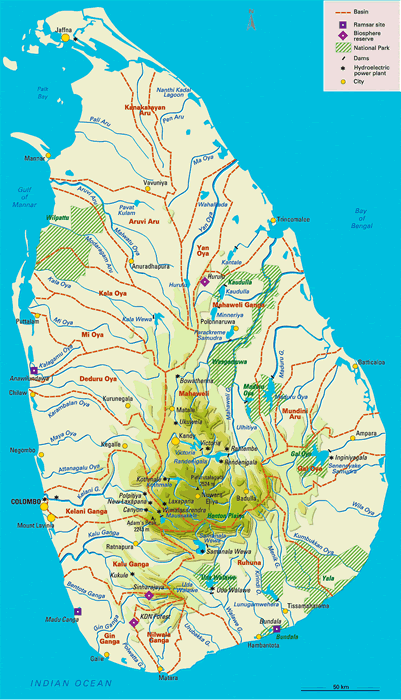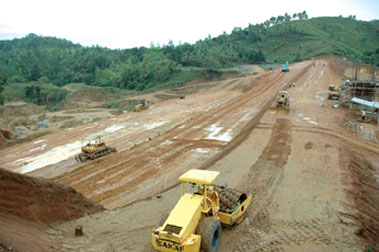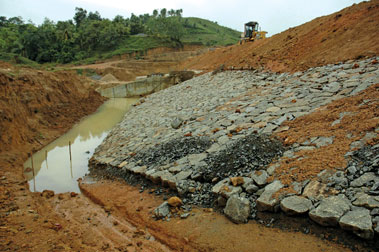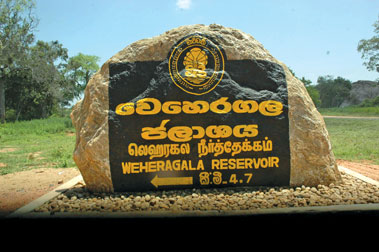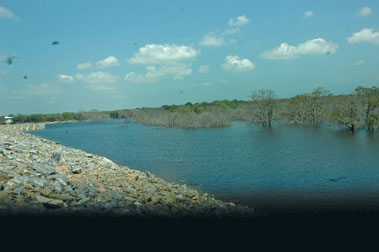Ilankai Tamil Sangam28th Year on the Web Association of Tamils of Sri Lanka in the USA |
|||||||||||
 Home Home Archives Archives |
Rebirth of Hydraulic Civilisation in Sri Lankaby Walter Liyanarachchi, Daily News, January 13, 2010
Waterworld: Ancient Sinhalese Irrigation, see below. I am firmly of the view that a new approach is necessary to resolve problems faced by farmers. This new approach has to be vastly different from the election promises given by politicians who represent the elite and live in luxury mansions in Colombo and are therefore attempting to force alien values on our farming community.” - Mahinda Chinthana The irrigation industry in Sri Lanka is functioning under the guidance of Ports, Aviation and Irrigation Minister Chamal Rajapaksa. His Ministry is one of the most important Ministries. Access to water and irrigation is a major determinant of paddy cultivation and the stability of yields. The rapport between water resource and agriculture will not survive without irrigation. Since Sri Lanka is an agro-based country, from time immemorial, the value of a systematic irrigation scheme was felt by the Sri Lankan rulers from 1948. The first multi-purpose reservoir project during the regime of D.S.Senanayake came into existence in 1949. During 1940’s several other projects such as Minipe, Nalanda Oya, Kandalama tank, Dambulla wewa, Walawe reservoir, Kirindi Oya reservoir, Kantale augmentation scheme, Parakrama Samudra, Nuwarawewa, Heda Oya reservoir were considered to be rehabilitated and came under investigation.
However during the recent past the rulers paid less attention to improving the irrigation works in the country. It is reported that except rehabilitating few tanks, no large projects to develop irrigation have been implemented. Realising the importance of developing the irrigation works in Sri Lanka, the present govertnment believed that self- suffciency could only be achieved through a strong and systematic irrigation system. In view of this fact, President Mahinada Rajapaksa had drawn a special program to streamline the planned proposals to develop irrigation works in Sri Lanka. The concept was penetrated so hard, the President embodied a clause in his policy statement - ‘Mahinda Chintana’. It states: “Our farmers undergo severe suffering due to the scarcity of water, non-availability of land, crop losses, poor markets for their produce and lack of access to technology. I am fully aware and familiar with their problems and expectations. Hence, I am firmly of the view that a new approach is necessary to resolve problems faced by farmers. This new approach has to be vastly different from the election promises given by politicians who represent the elite and live in luxury mansions in Colombo and are therefore attempting to force alien values on our farming community.” “Water is one of the prime resources of our country. The owners of this valuable resources should be the people of this country. I will firmly assure this position.” “I intend to present a national irrigation plan where the main rivers, regional tanks, anicuts and water streams in villages will be connected. Dry lands in the North, South, East and West will be transformed to fertile agricultural lands”. Taking a serious note to improve the irrigation works in Sri Lanka, President had entrusted this difficult task to Irrigation, Port and Aviatiohn Minister Chamal Rajapaksa who has a wide knowledge in irrigation systems. Minister Rajapaksa formulated plans with the assistance of the engineers, a large number of new projects and the Irrigation Officials readily accepted the challenge and rehabilitated a large number of major and minor irrigation schemes before schedule which were neglected for a long time. Barren and abandoned cultivable lands were converted to green paddy fields producing high yields.
The irrigation Department shying away the lethargic attitude, suddenly invigorated with the government’s stimulation, commenced implementing the proposed projects. With the encouraging cooperation shown by the government towards the Irrigation Department, the engineers and all concerned in the industry flocked together to materialise the projects. As a result of a constructive policy to develop the irrigation works was drawn to meet the water requirement of the country. At present the mission to meet the requirement of the policy is achieved through the implementation of a series of programmes and projects which can be broadly classified under the following areas. a. Planning, design, construction and operation of infrastructure facilitiies required to harness the surface water for land development. b. Integrated natural resource management in major irrigation systems in order to increase producitivity. c. Assessment of water resources in river basin planning and dev elopment, inclusive of stream flow forecasting and warning. d. Increased beneficiary involvement through a joint system of management in major irrigation schemes. e. Providing drainage facilities to low lying areas and prevention of flooding and salt water intrusion. In order to achieve the above objectives, the Irrigation Department has identified the following tasks. The establisment of the four sub-departments within the Irrigation Department few years back was done by keeping these under each of these sub departments are given below
a. Investigation, planning and designing of infrastructural elements of water resources development for irrigation and flood control. b. Construction of all major and mninor reservoirs, diversion weirs and related structures for water delivery and agricultural development in the down stream areas. c. Operation and management of all major irrigation schemes including the institutional strengthening in major irrigation systems. With the assistance of the President and with the guidance of the Minister the Irrigation Department could complete 90% of the planned projects during the period 2009 and few are at the stage of completion. The main projects are, Deduru Oya, Rambukkan Oya, Veli Oya, Veheragala, Veemedilla reservoir and Kekiri Oboda. Out of these projects the Veheragala and Kekiri Oboda tanks are newly built reservoirs. The Veheragla tank project is completed and the Kekiri Oboda project is underway. During the recent past no government has undertaken to build new tanks. Building a new tank is not an easy task since it involves many matters. Firstly, a large amount of money has to be spent and an efficient scientific expertise in hydraulic technogy is needed. Deduru Oya Project Deduru Oya Project involves directly local expertise and necessary funds are provided by government coffers. The total expenditure is Rs. 6200 millions and with the completion of the project, 25,000 families are to be benefitted.
The Deduru Oya, originating from the eastern boarder of the Central Province is the main water source in the basin. It runs across Kurunegala and Puttalam District and enters the sea at Chilaw. The total length of the main stream of the river is about 115 km. and comprises of 9 tributories. The total land area falling under the basin is about 2600 square km out of which 3% is in”Central Province (Kandy and Matale District) and the rest in the north western province 88% in Kurunegala and 9% in Puttalam Districts. Nearly 50% of the families in the basin are below poverty line and receive poverty alleviation assistance under Samudhi programme from the government. Rambukkan Oya Project The prolject is implemented in Mundeni Oya Divisional Districts in Ampara District. The tank is being built across the Rambukkan Oya which bears a capacity of 45,000 acre feet. When completed the new paddy lands exceedng 3500 acres could be irrigated, an Irrigation Official said. The main dam is 3600 feet in length and the maximum height is 81 feet. The length of the main canal is 4.75 kilometers and the left tributoty is 17 kms. Maha Oya is being identified as a difficult area in which poverty is prevailing. With the implementation of the project, the poverty alleviation exercise could be doubled to a greater extent by providing water to the needy farmer. ------------------------------------------------------------ Waterworld: Ancient Sinhalese Irrigation Sri Lanka is a classic example of the "hydraulic civilization" which had developed in the ancient period. With the immigration of Aryans from Eastern India to Lanka in 543 BC, cultivation of rice developed into a grand scale in the island. As the new essentially agricultural Aryan civilization flourished, increasingly ambitious projects of irrigation were launched at a pace with a view to harness the monsoon rains. It can be safely deduced that the first great reservoirs ever in the world were built in Sri Lanka. since the great lakes of Egypt, being merely natural hollows into which streams were turned do not fall into the category of man-made rainwater reservoirs as those of Lanka.
During the reign of the great king, Lanka became to be known as the Granary of the Orient. King Parakramabahu the great was responsible for construction or the restoration of 165 dams, 3910 canals, 163 major tanks (=reservoirs) and 2376 minor tanks, all in a reign of 33 years, achieving supreme developments in irrigation and agriculture of the Sinhalese civilization during its 2550 year long history. The Sea of Parakrama (Parakrama Samudra) Network of canals to surrounding area "Many are the instances where the modern engineer has frequently found himself anticipated by an unnamed predecessor" Ceylonese historian R. L Brohier
| ||||||||||
